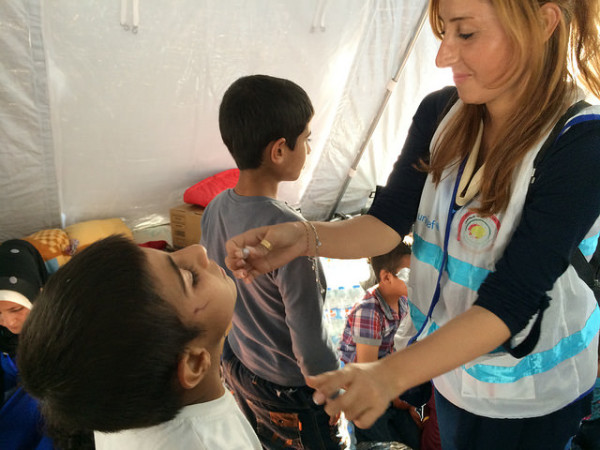The “biggest refugee crisis since World War Two” is quickly becoming “the biggest refugee crisis including World War Two” its third year in, having displaced more than four million people,* with over half of them minors under the age of 18. Refugee children who have crossed oceans to reach EU nations are chased by more than just political turmoil. Infectious diseases such as polio, measles, and hepatitis have reemerged in non-vaccinated children in the wake of Syria’s demolished healthcare infrastructure. In particular, polio outbreaks among refugee children demonstrate the urgent need for a concerted, sustained response to curb a global health care crisis.
Increased risk factors–such as food insecurity, a large number of displaced persons, and decreased hygiene–for infectious diseases in conflict zones may not surprise historians, and the poliomyelitis virus is no exception. However, the resurgence of polio roused enough worry that WHO declared a “global health emergency” in May 2014. The polio outbreaks in Syria dismantled the CDC’s hopes, in early 2013, of the eradication of polio, which was then constrained to three pockets of the world: Nigeria, Afghanistan, and Pakistan.
Image Source: Chris McGrath.
Both the Syrian government regime and the anti-government forces have attacked and appropriated hospitals and health care workers as a tactic of warfare. The Taliban militants’ anti-vaccination stance in Pakistan has bled into Syria where jihadists have threatened to kill vaccination workers on sight. The Taliban’s anti-vaccination stance may be attributed to how genetic samples from vaccinations helped lead to their leader Osama bin Laden’s capture. “After rumors spread that [the physician] was connected to the CIA, every vaccination worker in Pakistan fell under suspicion” (ibid). Active persecution has resulted in a mass exodus of healthcare providers, including the emigration of 80,000 doctors, leading to regions such as in Aleppo, Syria, where there are about 35 surgeons left to handle injuries in two million people.
The credit for most of the 1.4 million vaccinated children in 2014 goes to a “Polio Task Force,” assembled by regional Syrian healthcare providers, providing a model for a concerted response. As the polio vaccine must be administered in multiple doses to be effective, they had to track every child vaccinated—an ambitious endeavor. In an environment where healthcare providers are persecuted. As one doctor indicated in a correspondence:
“In Hama, we had to smuggle the vaccines past checkpoints in canisters on the milk truck. Vaccinators started work at midnight, as government snipers tended to shoot at them during the day[…] It’s too dangerous to ink the children’s fingers, or mark the doorways [to indicate that they have been vaccinated]–the government would have killed them for disloyalty.”
Most children had to be tracked an additional two times, as the weaker version of the vaccine was trivalent, and had to given in three doses separated by time intervals. Bivalent vaccinations were donated by organizations such as WHO and Save the Children, but shipping them in conflict zones became difficult. Especially in Northern Syria, a quarter of a million vaccines donated by Save the Children remained unused due to miscommunication.
The response of the Polio Task Force may serve as a model for a global health care response. As more children are born and displaced by the ongoing conflict, more vaccinations must be administered. Currently other infectious diseases such as hepatitis, measles, and cutaneous leishmaniasis are are also placing demands on healthcare workers. Nations are responding differently to this humanitarian crisis; the Jordan government is sponsoring vaccinations for incoming children, while the EU is paying Turkey to take in more refugees.
Image Source: Anadolu Agency.
Some healthcare workers, fearing airstrikes, are making house calls to children who still have homes. Some children flee as unaccompanied minors to resist recruitment as child soldiers. They find themselves facing more fences, erected by nations such as Hungary that mounted xenophobic campaigns to rally public support for these fences, denied the “universal” right to seek asylum. This is no longer a single nation’s public health crisis. As these children seek asylum, surrounding countries must meet the needs of a population chased by infectious diseases, bullets, and the inconsolable memory of broken homes.
*To put this number in perspective, around seven to nine million people were estimated to have been displaced during World War Two. Around 7.6 million Syrians have been internally displaced.
Featured Image: border 9 by European Commission DG ECHO.










